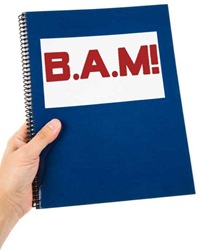Can you imagine how difficult it is for new employees to start interacting with customers? Every exchange, every decision is a new experience for them. They have to make split-second decisions while processing information they’ve never encountered before. Can you imagine what that’s doing to your brand?
All the hard thinking you’ve done to create your brand may be going down the tubes at the point of contact with the customer. In The Brand Gap, Marty Neumeier says “The secret of a living brand is that it lives throughout the company, not just in the marketing department.” Does your brand stop in the conference room? Does it live only in the executive office? If so, it’s easily correctable with a little brand training and something I call B.A.M! -a Brand Aptitude Manual
Companies often ask employees to deliver a brand experience that they themselves have never received. To leave it up to (often under-paid) employees who were not included in the strategy sessions is brand suicide. They must learn the brand and you must teach it to them. That’s easily accomplished if you develop a Brand Aptitude Manual for your business.
Typical Employee Training
If new employees receive any training at all, it’s typically in these areas:
- Functional – What the job function is, what mechanical actions to take, when to take them.
- Technical – How to run the software, how to run the register.
- Operational – Here’s who does what in the company and how it all connects.
What’s missing, of course, is brand training. Brand delivery is as important, and maybe even more so, than all the items listed above. Your brand is your identity. Customers build an emotional and psychological relationship with you based on your brand. Do you want to leave the development of that relationship up to the uneducated decisions of a brand new college graduate or a minimum-wage high school student?
The Brand Aptitude Manual
My guess is you answered “no” to the last question and that means it’s time to develop a Brand Aptitude Manual, or B.A.M! for short, because it will have a huge positive impact on your business. But no worries, they are actually easy to put together if you’ve already done the basic work of brand building.
Here’s what you include in your B.A.M!
I. Brand Foundations
- Your brand mission – What you want to accomplish for your customers.
- Your brand promise – What you promise to deliver beyond the product or service you happen to sell.
- Your brand personality – The flavor of the delivery of your brand promise.
II. Brand Commandments
Every business has certain things that must be done to keep the brand alive. At the same time there are certain things that should absolutely not be done because they are brand killers. Create a list of “Thou Shalts” and “Thou Shalt Nots” for your business. Include them in the B.A.M!
III. Situational Brand Questions
You want to get your employees thinking like your brand. So when they encounter a new situation they make the correct brand decision. Develop situational brand questions and include them in the B.A.M! Then quiz your employees on these situations.
To develop these questions, take potential real situations and ask your employees what they would do. Give them a few options, let them choose, then discuss with them what really should have been done. It goes something like this:
“An irate customer calls you on the phone. They said their order should have arrived yesterday. They contend you promised seven-day delivery and they ordered seven days ago. You check and see that they only ordered 5 days ago. Do you…..” Get them to answer that question like your brand.
……………
Your employees are the brand at the point of contact with the customers. Don’t leave that to chance. Employees need to be trained on brand delivery. Do you have a brand training program? What would you put in your B.A.M!? What situational questions would you include?
If you enjoyed this article, consider subscribing to this blog and let future podcast episodes and articles come to you: Receive The Marketing Spot by Email or ![]() Get The Marketing Spot in a blog reader
Get The Marketing Spot in a blog reader


[…] recommend creating a Brand Aptitude Manual to properly train your employees for brand […]